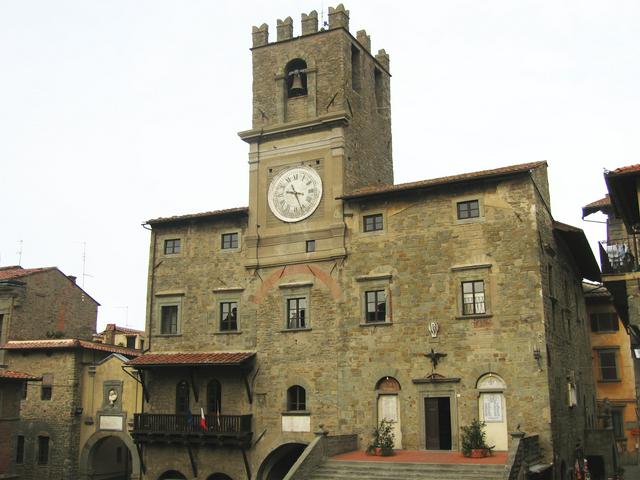
Cortona is a town in the Province of Arezzo, Tuscany. It was one of the twelve cities of the Etruscan League. At 600 metres elevation, it has magnificent panoramas to every point of the compass. It is not far from Arezzo.
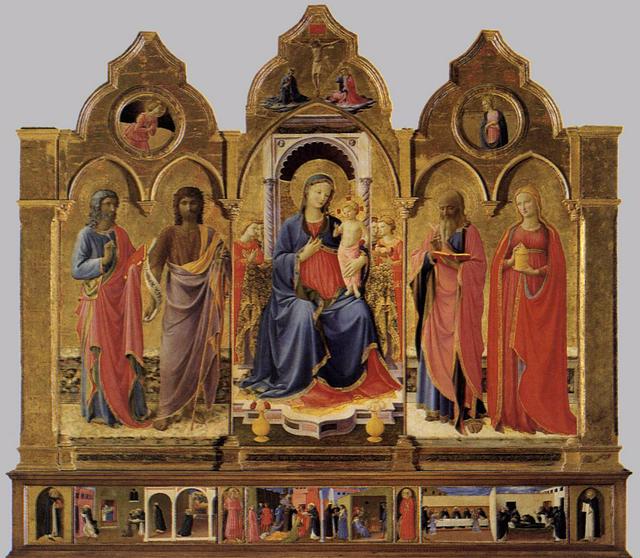
- Fortezza del Girofalko was erected on order of Grand Duke Cosimo I de Medici above the city (651 m above sea level) in the 16th century. It offers a splendid view over the city walls.
- Etruscan tombs
- Palazzo Ferretti, Rugapiana. Built in 1730 by the German architect Marco Tsucher; today the court of law.
- Palazzo Comunale (Town Hall), Piazza della Repubblica. Built at the beginning of the 13th century and reconstructed around 1275 by Master Tuto. The balcony on the facade was added in the 16th century. The councilors' hall dated from the original building. It has a roof with painted beams and a 16th-century chimney piece.
- Palazzo Passerini, Via Maffei. Originally the Palazzo del Capitano del Popolo was built in the 13th century. Its tower was destroyed later. The interior of the palace was renovated by Cardinal Silvio Passerini, who owned the palace from 1514 onwards. It appears to be as a vacation rental location.
- Palazzo Mancini Sernini, Via Guelfa 5. The palace is the work of Giovanni Battista di Cristofano Infregliati, called Cirstofanello. It was begun in 1533. Today it is the seat of the Banca Populare of Cortona.
- Palazzo Casali, Piazza Signorelli. The original palace was built in the 14th century. It was the seat of the Casali family, lords of Cortona until 1409. only a few walls of the original building remained. The Renaissance front from the beginning of the 17th century is the work of Filippi Berretini. Today the palace is the seat of the city library, the historical archive, the Etruscan Museum and the Etruscan Academy. The courtyard of the Casali Palace is the best photo stop in Cortona.
- Palazzone. The Renaissance building was erected on order of Cardinal Silvio Passerini (1469-1529), who was commissioner of the Pope for Umbria and envoy to Perugia. It was designed by Giovan Battista from Perugia. It is reported that the painter Luca Signorelli fell from the scaffolding while painting the frescoes for the cardinal's chapel and died here. Today the Palazzone is part of the Scuola Normale di Pisa.
Palazzo Ferretti, Rugapiana. Built in 1730 by the German architect Marco Tsucher; today the court of law.
Palazzo Comunale (Town Hall), Piazza della Repubblica. Built at the beginning of the 13th century and reconstructed around 1275 by Master Tuto. The balcony on the facade was added in the 16th century. The councilors' hall dated from the original building. It has a roof with painted beams and a 16th-century chimney piece.
Palazzo Passerini, Via Maffei. Originally the Palazzo del Capitano del Popolo was built in the 13th century. Its tower was destroyed later. The interior of the palace was renovated by Cardinal Silvio Passerini, who owned the palace from 1514 onwards. It appears to be as a vacation rental location.
Palazzo Mancini Sernini, Via Guelfa 5. The palace is the work of Giovanni Battista di Cristofano Infregliati, called Cirstofanello. It was begun in 1533. Today it is the seat of the Banca Populare of Cortona.
Palazzo Casali, Piazza Signorelli. The original palace was built in the 14th century. It was the seat of the Casali family, lords of Cortona until 1409. only a few walls of the original building remained. The Renaissance front from the beginning of the 17th century is the work of Filippi Berretini. Today the palace is the seat of the city library, the historical archive, the Etruscan Museum and the Etruscan Academy. The courtyard of the Casali Palace is the best photo stop in Cortona.
Palazzone. The Renaissance building was erected on order of Cardinal Silvio Passerini (1469-1529), who was commissioner of the Pope for Umbria and envoy to Perugia. It was designed by Giovan Battista from Perugia. It is reported that the painter Luca Signorelli fell from the scaffolding while painting the frescoes for the cardinal's chapel and died here. Today the Palazzone is part of the Scuola Normale di Pisa.
- Piazza della Repubblica: the most famous piazza in Cortona. The fountain in the center of the square was destroyed around 1550. It is presumed that it looked similar to the Fontana Maggiore in Perugia.
- Piazza Signorelli: next to the Piazza della Repubblica and less crowded. On Sundays it has a flea market where they sell antiques. The Teatro dell Signorelli and the Casali Palace are here.
- Piazza Garibaldi Built by the French during the Napoleonic Wars
- PIazza Pescheria (Fish market) with the Passerini Palace.
Piazza della Repubblica: the most famous piazza in Cortona. The fountain in the center of the square was destroyed around 1550. It is presumed that it looked similar to the Fontana Maggiore in Perugia.
Piazza Signorelli: next to the Piazza della Repubblica and less crowded. On Sundays it has a flea market where they sell antiques. The Teatro dell Signorelli and the Casali Palace are here.
Piazza Garibaldi Built by the French during the Napoleonic Wars
PIazza Pescheria (Fish market) with the Passerini Palace.
- Rugapiana is the main street of Cortona with houses dating from the 16th to 18th centuries and the Ferretti Palace.
- Vicolo della Scala and Vicolo Vagnucci
- Via Roma with the Porta del Morto (Door of the Death) from 1247 and the Palazo Cinaglia
Rugapiana is the main street of Cortona with houses dating from the 16th to 18th centuries and the Ferretti Palace.
Vicolo della Scala and Vicolo Vagnucci
Via Roma with the Porta del Morto (Door of the Death) from 1247 and the Palazo Cinaglia
- The Cathedral (Il Duomo) Summer daily 7:30AM-1PM and 3:30-6:30PM; winter daily 8AM-12:30PM and 3-5:30PM. Free admission. The cathedral was built above the old church of Santa Maria, erected in the 10 and 11th centuries, the front of which was altered ny Nicolo Pisano around 1260. Traces of the first building can still be found on the front of the cathedral. The new building dates from the 15th cent. Although the cathedral has been rebuilt many times it has not lost the harmony of the original building.
- Santa Maria Nuova. The church was built in the 2nd half of the 16th cent on plans of Cristofanello in Late Renaissance style. It was finished in the 17th cent and is located in a splendid position at the base of S.Egidio Mount. It has a painting of the Nativity of Mary by Allori.
- Eremo Le Celle. A Fransiscan monastery on the slopes of Mount S.Egidio. The cell which was inhabited ba Saint Francis has been preserved. free entrance.
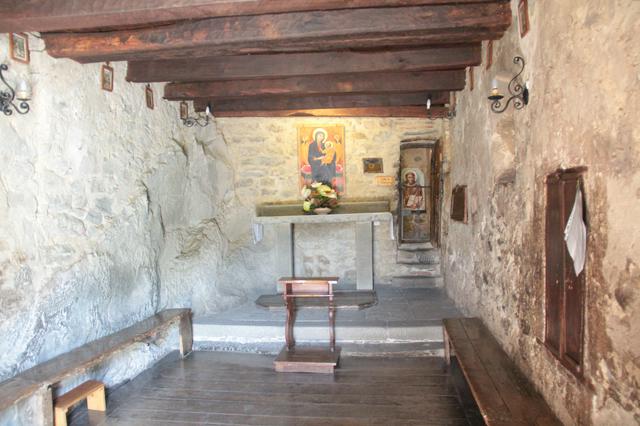
- Farneta Abbey, old abbey, erected in the 9th and 10th century AD by the "Black" Benedictine monks from Monte Cassino on the foundations of a Roman temple.One of the columns of pink granite originates from Aswan in Egypt and has a Roman capital with a human figure with horns on the head. In the center of the crypt is a splendid monument similar to a small temple. There is also a Roman stela with the inscription "fourth daughter of Erennius Pompeius libertus" (liberti beeing freed slaves).
- San Benedetto, built in the 18th century on an oval plan with an outside staircase.
- San Domenico, built in the 12th century in Gothic style, The altar-piece has a painting of the Coronation of Mary by Lorenzo di Niccolò Gerini (16th cent) with six angels practising music and ten figures of saints, in the center, above it the Trinity, the annunciation, the adoration of the magi and four events from the life of St.Benedict. The altar on the right hand side in the apsis has a painting of Holy Virgin with angels and sainmts by Luca Signorelli (1455-1523). On the left wall is a wall painting by Beato Angelico (15th century).
- San Francesco, Via Santucci, Gothic building erected after 1425 by the Franciscan monk Elia who is also buried in the church. Traces of the original building can be seen at the main entrance, at the side windows and the frescoes which are attributed to the painting school of Buffalmacco (15th century). The side altars were added in BAroque times. The marble tabernaclen on the high altar is a work of Bernardino Ricci (17th century) and is believed to contain a reliquiary of the Holy Cross that was brought from Constantinople by the monk Elia. The inner part of the tabernacle is a Byzantine piece of art dating from the 10th century. The third altar on the left hand side has a painting of the Annunciation, the last and unfinished work of Pietro Berretini (also called Il Cortona).
- Santa Margherita,completely restored in the 19th century. The silver shriene containg the body of the saint was executed after drawings by Pietro Berretini. In the church there is also a wooden crucifix dating to the 13th cent.
- Santa Maria delle Grazie (Church of Calcinaio), supposed to be the most beautiful Renaissance monument in Cortona. It is named after the old limestone quarry (calcinaio) which was owned by the shoemakers guild. The church is considered as the masterpiece of Francesco di Giorgio Martini. It was built between 1485 and 1513 on the plan of a Latin cross with a eight-sided dome above it. The stained windows are the work of William of Marcillat, the main portal and high altar were designed by Bernardino Covatti of Cortona.
- San Niccolò, a small Romanic church from the 15th century
- San Filippo, near Palazzo Chinaglia, Baroque building of 1720,
- San Agostino, erected in the 13th century in Gothic style, altered in the 17th cent in Baroque style. It contains the painting Our Lady with Saints by Berrettini (1596-1669). The cloisters were added in the 17th cent,
- San Cristoforo, dating back to the 12th century, but frequently re-built. Frescoes of the Umbrian school from the 13th century.
- La Contessa, a building from the 13th century founded by a countess ("Contessa") as a monastery, today a school for hotel and tourism management.
- San Michele Arcangelo, 5 km from Cortona, a Romanic-Byzantine church which was already in existence in 1000, presumably the work of Meginardo by order of bishop Teobaldo of Arezzo.
The Cathedral (Il Duomo) Summer daily 7:30AM-1PM and 3:30-6:30PM; winter daily 8AM-12:30PM and 3-5:30PM. Free admission. The cathedral was built above the old church of Santa Maria, erected in the 10 and 11th centuries, the front of which was altered ny Nicolo Pisano around 1260. Traces of the first building can still be found on the front of the cathedral. The new building dates from the 15th cent. Although the cathedral has been rebuilt many times it has not lost the harmony of the original building.
Santa Maria Nuova. The church was built in the 2nd half of the 16th cent on plans of Cristofanello in Late Renaissance style. It was finished in the 17th cent and is located in a splendid position at the base of S.Egidio Mount. It has a painting of the Nativity of Mary by Allori.
Eremo Le Celle. A Fransiscan monastery on the slopes of Mount S.Egidio. The cell which was inhabited ba Saint Francis has been preserved. free entrance.
Farneta Abbey, old abbey, erected in the 9th and 10th century AD by the "Black" Benedictine monks from Monte Cassino on the foundations of a Roman temple.One of the columns of pink granite originates from Aswan in Egypt and has a Roman capital with a human figure with horns on the head. In the center of the crypt is a splendid monument similar to a small temple. There is also a Roman stela with the inscription "fourth daughter of Erennius Pompeius libertus" (liberti beeing freed slaves).
San Benedetto, built in the 18th century on an oval plan with an outside staircase.
San Domenico, built in the 12th century in Gothic style, The altar-piece has a painting of the Coronation of Mary by Lorenzo di Niccolò Gerini (16th cent) with six angels practising music and ten figures of saints, in the center, above it the Trinity, the annunciation, the adoration of the magi and four events from the life of St.Benedict. The altar on the right hand side in the apsis has a painting of Holy Virgin with angels and sainmts by Luca Signorelli (1455-1523). On the left wall is a wall painting by Beato Angelico (15th century).
San Francesco, Via Santucci, Gothic building erected after 1425 by the Franciscan monk Elia who is also buried in the church. Traces of the original building can be seen at the main entrance, at the side windows and the frescoes which are attributed to the painting school of Buffalmacco (15th century). The side altars were added in BAroque times. The marble tabernaclen on the high altar is a work of Bernardino Ricci (17th century) and is believed to contain a reliquiary of the Holy Cross that was brought from Constantinople by the monk Elia. The inner part of the tabernacle is a Byzantine piece of art dating from the 10th century. The third altar on the left hand side has a painting of the Annunciation, the last and unfinished work of Pietro Berretini (also called Il Cortona).
Santa Margherita,completely restored in the 19th century. The silver shriene containg the body of the saint was executed after drawings by Pietro Berretini. In the church there is also a wooden crucifix dating to the 13th cent.
Santa Maria delle Grazie (Church of Calcinaio), supposed to be the most beautiful Renaissance monument in Cortona. It is named after the old limestone quarry (calcinaio) which was owned by the shoemakers guild. The church is considered as the masterpiece of Francesco di Giorgio Martini. It was built between 1485 and 1513 on the plan of a Latin cross with a eight-sided dome above it. The stained windows are the work of William of Marcillat, the main portal and high altar were designed by Bernardino Covatti of Cortona.
San Niccolò, a small Romanic church from the 15th century
San Filippo, near Palazzo Chinaglia, Baroque building of 1720,
San Agostino, erected in the 13th century in Gothic style, altered in the 17th cent in Baroque style. It contains the painting Our Lady with Saints by Berrettini (1596-1669). The cloisters were added in the 17th cent,
San Cristoforo, dating back to the 12th century, but frequently re-built. Frescoes of the Umbrian school from the 13th century.
La Contessa, a building from the 13th century founded by a countess ("Contessa") as a monastery, today a school for hotel and tourism management.
San Michele Arcangelo, 5 km from Cortona, a Romanic-Byzantine church which was already in existence in 1000, presumably the work of Meginardo by order of bishop Teobaldo of Arezzo.
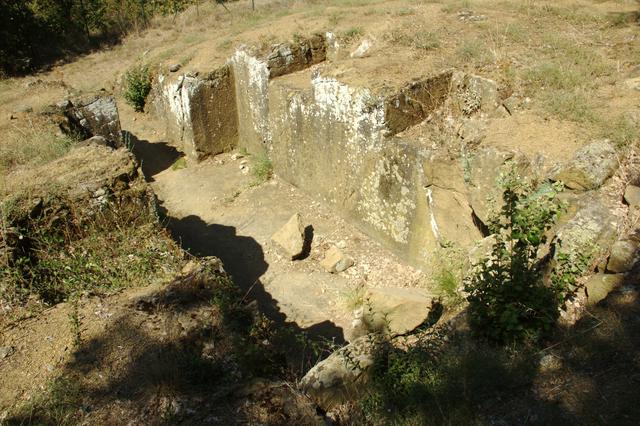
- MAEC - Museo dell'Accademia Etrusca e della Città di Cortona, Palazzo Casali, piazza Signorelli, 9, +39 0575 637235. Apr to Oct: Tu-Sa 10:00-19:00; Nov to Mar: Tu-Sa 10:00-17:00, closed Dec 25. Among the exhibits are a slate slab of Polymnia, an Etruscan lamp of the 5th cent BC, a Bronze votive hand, a statue of the two-headed god Janus, a tryptich of Our Lady and Saints by ‘’Bicci di Lorenzo’’ (16th century), an Egyptian wooden boat of the dead from the 12th dynasty (2000 to 1788 BC). You can download a plan of the museum here €10, combined with Museo Diocesano €13.
- Museo Diocesano, Piazza del Duomo, +39 575 62830. Apr to Oct: daily 10:00-19:00; Nov to Mar: Tu-Su 10:00-17:00, closed Dec 25. The Diocesan Museum is in the original Church and Oratory of Gesù. The Church was built by the Lay Company of Buon Gesù between 1498 and 1505 and was made up of an oratory on the lower floor and a church on the upper floor. The church had a single nave with three altars with three masterpieces by Luca Signorelli. Among the most important exhibits are: an Annunciation by Fra Angelico, Lamentation over the dead Christ by Luca Signorelli, a Shaped Cross by Pietro Lorenzetti and the Passerini Tapestry, vestments made between the beginning of the 16th century and 1515, commissioned by Cardinal Silvio Passerini to be worn by Pope Leo X de’ Medici during his visit in Cortona. admission €5, children €3.
MAEC - Museo dell'Accademia Etrusca e della Città di Cortona, Palazzo Casali, piazza Signorelli, 9, +39 0575 637235. Apr to Oct: Tu-Sa 10:00-19:00; Nov to Mar: Tu-Sa 10:00-17:00, closed Dec 25. Among the exhibits are a slate slab of Polymnia, an Etruscan lamp of the 5th cent BC, a Bronze votive hand, a statue of the two-headed god Janus, a tryptich of Our Lady and Saints by ‘’Bicci di Lorenzo’’ (16th century), an Egyptian wooden boat of the dead from the 12th dynasty (2000 to 1788 BC). You can download a plan of the museum here €10, combined with Museo Diocesano €13.
Museo Diocesano, Piazza del Duomo, +39 575 62830. Apr to Oct: daily 10:00-19:00; Nov to Mar: Tu-Su 10:00-17:00, closed Dec 25. The Diocesan Museum is in the original Church and Oratory of Gesù. The Church was built by the Lay Company of Buon Gesù between 1498 and 1505 and was made up of an oratory on the lower floor and a church on the upper floor. The church had a single nave with three altars with three masterpieces by Luca Signorelli. Among the most important exhibits are: an Annunciation by Fra Angelico, Lamentation over the dead Christ by Luca Signorelli, a Shaped Cross by Pietro Lorenzetti and the Passerini Tapestry, vestments made between the beginning of the 16th century and 1515, commissioned by Cardinal Silvio Passerini to be worn by Pope Leo X de’ Medici during his visit in Cortona. admission €5, children €3.
- The cistern of the Bagni di Bacco
- Etruscan wall-remains within P.zzo Cerulli-Diligenti
- Etruscan wall-remains within Palazzo Casali
- Etruscan walls
- Porta Bifora
- Barrel vault in the Via Guelfa. You will find details here
- Tuscan Sun Festival. An annual event in summer. Festival with concerts performed by the world’s most acclaimed musical artists, exhibitions with leading visual artists, discussions with top literary figures and culinary delights with the finest chefs and winemakers.
Tuscan Sun Festival. An annual event in summer. Festival with concerts performed by the world’s most acclaimed musical artists, exhibitions with leading visual artists, discussions with top literary figures and culinary delights with the finest chefs and winemakers.
Fortezza del Girofalko was erected on order of Grand Duke Cosimo I de Medici above the city (651 m above sea level) in the 16th century. It offers a splendid view over the city walls.
Etruscan tombs
- Cooking Class, offered by several hotels in Cortona:
* "Hotel Restaurant Corys" (see contact details in Sleep section).
* "Relais il Falconiere", Localitá San Martino, 370. One day cooking class in one Michelin star Restaurant. Classes begin at 16:30 (last approx. 3 hr). Available every week on request, all year round except for July and August. Prices: up to 2 person €180/person, 3 or more €160.
- 3D3 World Maya Training, Castello Neve (Poggioni, +39 0575 690 060. 5-, 10- and 20-day one teacher to one student intensive Maya 3D animation courses at 3D3 World at the Castello Neve. Training is by industry professionals and all meals and accommodation are included.
- Agriturismo Il Frantoio (Horseback Riding), Loc. San Martino a Bocena (5 minutes from Cortona, +39 335 7771771. Hours are flexible. Traditional riding ground with wooden stables accommodating over thirty horses. Horseback riding lessons, activities and trekking in the nearby woods are arranged daily. Rides are planned according to riding ability and your personal preference. You will also be able to assist in the daily tasks of the manège and in the training of horses. Outdoor dinners are arranged. Prices on request.
Cooking Class, offered by several hotels in Cortona:
* "Hotel Restaurant Corys" (see contact details in Sleep section).
* "Relais il Falconiere", Localitá San Martino, 370. One day cooking class in one Michelin star Restaurant. Classes begin at 16:30 (last approx. 3 hr). Available every week on request, all year round except for July and August. Prices: up to 2 person €180/person, 3 or more €160.
3D3 World Maya Training, Castello Neve (Poggioni, +39 0575 690 060. 5-, 10- and 20-day one teacher to one student intensive Maya 3D animation courses at 3D3 World at the Castello Neve. Training is by industry professionals and all meals and accommodation are included.
Agriturismo Il Frantoio (Horseback Riding), Loc. San Martino a Bocena (5 minutes from Cortona, +39 335 7771771. Hours are flexible. Traditional riding ground with wooden stables accommodating over thirty horses. Horseback riding lessons, activities and trekking in the nearby woods are arranged daily. Rides are planned according to riding ability and your personal preference. You will also be able to assist in the daily tasks of the manège and in the training of horses. Outdoor dinners are arranged. Prices on request.
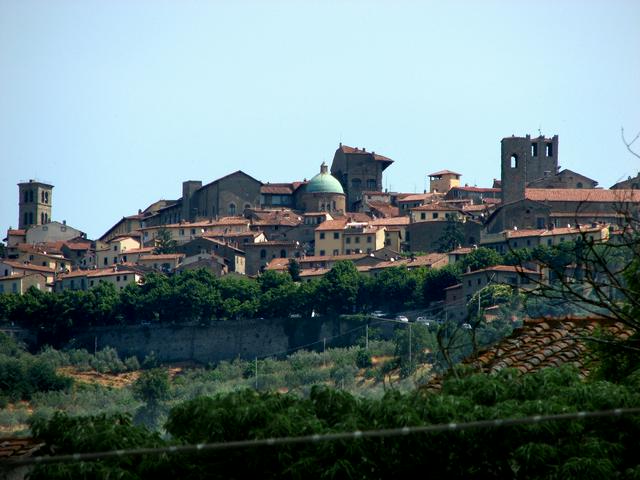
- Cantine Faralli, Loc. Fasciano 4.
- Wine Bar La Casa Gialla. Via Gramsci, 113 (S.S.71 Umbro Casentinese)
- Molesini Market Enoteca Prodotti Tipici, Piazza Repubblica, Tel. 62544.
Cantine Faralli, Loc. Fasciano 4.
Wine Bar La Casa Gialla. Via Gramsci, 113 (S.S.71 Umbro Casentinese)
Molesini Market Enoteca Prodotti Tipici, Piazza Repubblica, Tel. 62544.
- Pasticceria Banchelli, Via Matteotti, 119. Offers a fine selection of pastries, chocolates, cakes, espresso and cappuccino.
Pasticceria Banchelli, Via Matteotti, 119. Offers a fine selection of pastries, chocolates, cakes, espresso and cappuccino.
Cortona is small and loaded with tourists during the holiday season so that reservation is highly recommended, especially for dinner. Lunch and dinner are normally served at specific time so you might be sent away if you come outside this time. For less fancy eating possibilities, there are take-away pizza shops around Piazza della Repubblica.
- Trattoria Dardano, Via Dardano, 24. Closed W.
- Trattoria La Grotta, P.Baldelli 3. With outdoor tables in a secluded courtyard. Closed on Tuesday.
- Osteria del Teatro, Via Maffei, 2.
- Hosteria La Bucaccia, Via Ghibellina 17.
- Bar 500, 44/46 Via Nazionale, +39 3479172118. 12:00-23:00, closed Tu. Open Mar-Nov. Wine bar/restaurant in the historical centre of Cortona.
Gelateria Snoopy, Piazza Signorelli, 24.
Trattoria Dardano, Via Dardano, 24. Closed W.
Trattoria La Grotta, P.Baldelli 3. With outdoor tables in a secluded courtyard. Closed on Tuesday.
Osteria del Teatro, Via Maffei, 2.
Hosteria La Bucaccia, Via Ghibellina 17.
Bar 500, 44/46 Via Nazionale, +39 3479172118. 12:00-23:00, closed Tu. Open Mar-Nov. Wine bar/restaurant in the historical centre of Cortona.
The red wine Sangiovese is the pride of Tuscany and famous worldwide with the popular name "Chianti". The Syrah has also received high recognition.
- Caffè Degli Artisti, Via Nazionale, 18. Owned by Italian-Finnish couple.
Caffè Degli Artisti, Via Nazionale, 18. Owned by Italian-Finnish couple.
- The Lion's Well, Piazza Signorelli 28.
The Lion's Well, Piazza Signorelli 28.
- Route 66 Cafè, Via Nazionale, 71, Angolo Piazza Garibaldi.
Route 66 Cafè, Via Nazionale, 71, Angolo Piazza Garibaldi.
Tourist Information Agency (A.P.T.), Via Nazionale, 42.
Beware of your belongings as even when the town feels safe, it is still crowded by tourists which are good targets to pickpockets.
The town is hilly and some attractions (church or castle) are located on the hills so that it might be difficult to reach for some people. Consider renting a car if travelling with children or older people.
- The Archaeological Park - Extra-urban route covering:
- The Tomb of Mezzavia
- The Melone II of Sodo, Etruscan tomb of the 5th or 4th century BC, near SS 71
- The Melone I of Sodo, Etruscan tomb of the 5th or 4th century BC, near SS 71
- The Tanella Angori
- The Tanella di Pitagora (Tomb od Pythagoras). The name is due to a misunderstanding: Crotone was mixed up with the ancient Greek city of Kroton where Pythagoras died. The tomb is said to date from the 4th century BC.
- The Tumulus of Camucia, a tumulus with a diameter of 200 meters and 11 meters high.
- The Roman Villa of Ossaia
- The Roman road of Torreone: You may walk along this paved track in both ways alternatively starting from Torreone and hiking your way up to the Guglielmesca or driving up to the latter location and walking all the way down to Torreone. This trail running in the woods of the Cortona hills, also indicated as CAI trail nr. 561, offers, halfway, a stunning view over Cortona and the Valdichiana. You may also take a detour and hike down to the convent of the Cappuccini walking by the Maestà del Pianello a place where it is said to have been located the so-called “Tomb of the King”. The trail is equipped with basic road signs.
- The Roman road of Teverina Bassa
- The Roman road of Monte Maestrino
- Rocca di Pierle (Pierle fortress), 16 km from Cortona. The fortress was bilt by order of Francesco Casali in the Middle Ages on the ruins of an older castle. In 1387 more than 60 conspirators were confined and finally killed here by Uguccio Casali. In 1411 the fortress was sold by Ladislaus King of Naples to the Florentine Republic for 1200 florins, In the 16th century Grand Duke Francesco de Medici order the inner part of the fortress to be demolished in order to prevent 'evil-doers from Tuscany or the Papal State' to find refuge in the fortress.
- Arezzo, 33 km (21 miles)
- Florence, 116 km
- Siena, 73.4 km
The Archaeological Park - Extra-urban route covering:
- The Tomb of Mezzavia
- The Melone II of Sodo, Etruscan tomb of the 5th or 4th century BC, near SS 71
- The Melone I of Sodo, Etruscan tomb of the 5th or 4th century BC, near SS 71
- The Tanella Angori
- The Tanella di Pitagora (Tomb od Pythagoras). The name is due to a misunderstanding: Crotone was mixed up with the ancient Greek city of Kroton where Pythagoras died. The tomb is said to date from the 4th century BC.
- The Tumulus of Camucia, a tumulus with a diameter of 200 meters and 11 meters high.
- The Roman Villa of Ossaia
- The Roman road of Torreone: You may walk along this paved track in both ways alternatively starting from Torreone and hiking your way up to the Guglielmesca or driving up to the latter location and walking all the way down to Torreone. This trail running in the woods of the Cortona hills, also indicated as CAI trail nr. 561, offers, halfway, a stunning view over Cortona and the Valdichiana. You may also take a detour and hike down to the convent of the Cappuccini walking by the Maestà del Pianello a place where it is said to have been located the so-called “Tomb of the King”. The trail is equipped with basic road signs.
- The Roman road of Teverina Bassa
- The Roman road of Monte Maestrino
Rocca di Pierle (Pierle fortress), 16 km from Cortona. The fortress was bilt by order of Francesco Casali in the Middle Ages on the ruins of an older castle. In 1387 more than 60 conspirators were confined and finally killed here by Uguccio Casali. In 1411 the fortress was sold by Ladislaus King of Naples to the Florentine Republic for 1200 florins, In the 16th century Grand Duke Francesco de Medici order the inner part of the fortress to be demolished in order to prevent 'evil-doers from Tuscany or the Papal State' to find refuge in the fortress.
